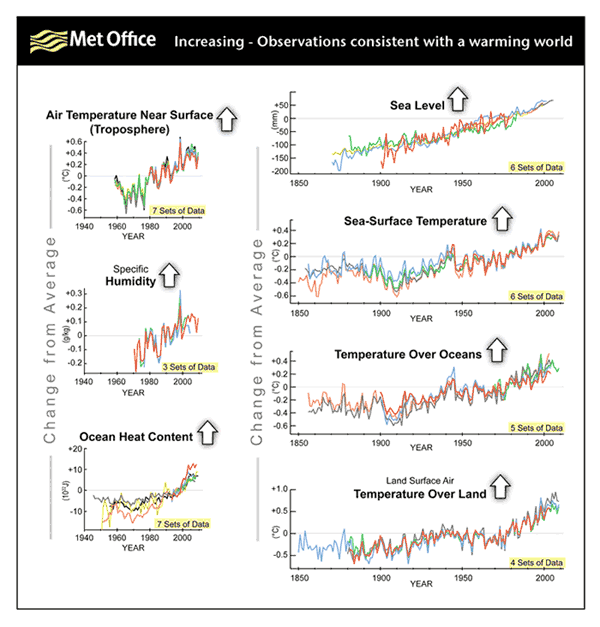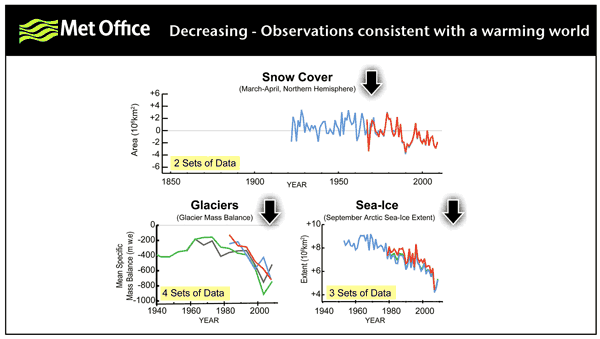8.1 Welcome to the Anthropocene - video
Another video presented by Prof. Tim Lenton of University of Exeter.
Key points:
- Humanity is on the threshold of a new geological epoch known as the Anthropocene.
- Exeter cathedral was founded in 1050 CE, when the mean global temperature was about 14 deg. C, and CO2 was 280 ppm in the atmosphere.
- May 2013 saw the 400 ppm level broken.
- If we were to burn all 4,000 billion tonnes of known fossil fuels, CO2 could rise to 1,500 ppm by 2300 CE.
- We could see global temperatures peak at 8 deg. C. higher than pre-industiral mean, and still be 6 deg. C. warmer by 3000 CE.
- CO2 is a more long-lived pollutant than radioactive pollutants, and it would take a million years for all the CO2 from fossil fuel burning to be returned to the lithosphere (solid part of Earth's crust and mantle) by silicate weathering.
- If we burn all the fossil fuels known, then we will break the approx 100,000 year ice-age cycle that has held true for the last 850,000 years, possibly entering a permanent hot period.
- This could see sea-levels rise by 10s of metres, and formation of a distinct new layer of sedimentary rock.
- But that assumes we actually burn all the fossil fuels!
8.2 Defining the Anthropocene - article
An article on the British Geological Survey's website on "The Antropocene".
Good bit to quote: Humans have caused a dramatic increase in erosion of the land surface and changes in sedimentation, through agriculture and construction, and also by other activities such as the damming of most major rivers. As well as these physical changes, the signal of chemical pollutants and radioactive waste that we have accumulated over the past 200 years will leave a signal that stretches into the distant future, and one which would be identified by geologists millions of years hence as identifying the Anthropocene.
8.3 How might it affect you? - discussion
How might rising sea levels affect you? With a link to this article in New Scientist. Which should have been this one.
I live in Exeter, so wouldn't directly be affected by rising sea-levels, but many of the towns and areas nearby would be. This winter we have already seen extensive flooding on the Somerset Levels nearby, and the rather spectacular damage done to the coastal railway line at Dawlish. The rail link to Bristol has been affected by flooding, and the rail link to London Waterloo was closed briefly due to a landslide. There has been a lot of erosion of the cliff faces in Sidmouth, the sand dunes have almost disappeared at Exmouth, and there has been lots of flooding and damage to walks and parks on the Exe estuary banks in Topsham. All of these have accumulated effects in changes to property values, the ability of the local economy to function through it's connections to the rest of the country, and possible impact on the tourist industry, which is a large employer in the South West of England.
8.4 Action - video
Presented by Prof. Tim Lenton.
Not sure I got a lot from this video, it's mainly wrapping things up and urging us to take action on a personal level to limit our greenhouse gas emissions.
Key points:
- Kyoto Protocol signed in 1997 expires in 2020, commits to keeping climate change to below 2 deg. C. achievable though a 60% reduction in emissions.
- This is a huge task, and for developing nations to continue developing, means those of us in developed nations need to cut back by even more.
- There is a bit of spiel from Exeter University Sustainability Manager - they have reduced carbon emissions by over 40% since 2005/6 - which is quite an acheivement I think.
- They have done this through technical fixes: draft-proofing, improving lighting controls, and improving the controls on boilers and adoption of renewable energy sources: ground source heat pumps and biomass boilers.
- We can reduce our footprint by flying less, driving less, using public transport and cycling more. Also doing things online and working from home over the internet.
- Can we de-couple economic growth from environmental degradation? Still unclear how to do this.
- Scientifically there is still much uncertainty around how much carbon will be taken up by vegetation, soils and the oceans.
8.5 Your carbon footprint - article
Article on the Energy Saving Trust website.
8.6 Take action: calculate your carbon footprint - discussion
A link to the the online calculator at the DirectGov website.
Using this my household may produce 1.2 tonnes of carbon (presumably this is per year?).
My appliances probably emit 0.49 tonnes of carbon per year.
My travel may emit 1.83 tonnes of carbon per year.
My total carbon footprint is 3.51 tonnes per year.
That sounds rather alarming to me, but the national average for my sort of household is 4.46 tonnes (1.99 home, 0.71 appliances, 1.76 travel) - I'm not convinced by that! I don't fly, or regularly commute by car or rail, our family car does a fairly low milage each year. Think I need to look into this a bit more!
This has a link to an article in New Scientist. Think they've got this the wrong way round from the other New Scientist link in section 8.3 (the first obvious mistake in the course material!).
8.8 Test
15 out of 15 get in!
8.9 Final Test (Part 1)
Q10 climate impacts of sea ice melting - didn't work out the answer to this.
22 out of 30 without revision or reference to notes...
8.10 Final Test (Part 2)
24 out of 30 this time.
8.11 Reflect - discussion
Well the recommendation is to go back and review the course material if you get less than 25 out of 30 for the to tests. Some of the questions recollection of obscure facts from several weeks ago, and felt a bit arbitrary! Anyhow, the thing is done and I enjoyed it. I shall write up a proper reflection another time, as it's getting late...

